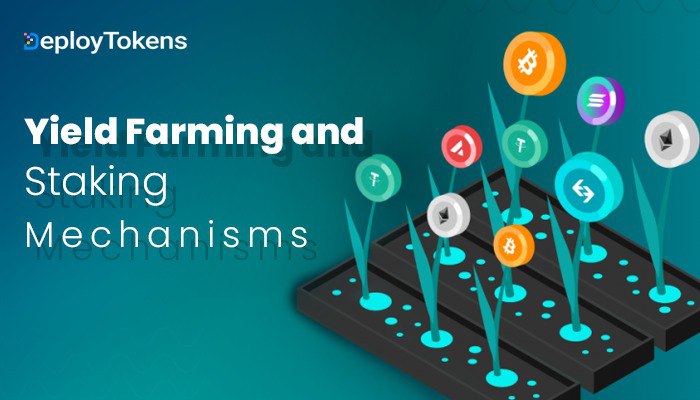So you’ve got some crypto sitting in your wallet, and you’re wondering: “Is there a way to make this money work for me?” Well, welcome to the world of DeFi staking where your digital assets can actually earn you passive income while you sleep.
Think of it like this: traditional banks pay you tiny interest rates for keeping money in savings accounts. DeFi staking? It’s the crypto equivalent, but way more exciting and potentially more profitable.
What Exactly Is DeFi Staking?
Let’s keep it simple. DeFi staking means locking up your crypto tokens in a smart contract to earn rewards. It’s like putting your money to work, but instead of building someone else’s empire, you’re helping secure blockchain networks and earning tokens in return.
There are two main flavors you should know about:
Proof-of-Stake (PoS) Staking is the OG method. You lock up your tokens (think Ethereum, Cardano, or Tezos) to help validate transactions on the blockchain. The network picks validators based on how much they’ve staked, and boom – you earn rewards in the form of additional tokens. Simple enough, right?
But here’s where it gets interesting: Liquid Staking is the new kid on the block that’s changing the game. Instead of your assets being completely locked away, you get a tradable token (like stETH from Lido) that represents your staked assets plus rewards. This means you can still use your staked crypto as collateral for loans or other DeFi activities. It’s like having your cake and eating it too.
Now Let’s Talk About Yield Farming
If DeFi staking is earning steady interest, yield farming is like playing 3D chess with your crypto. Also called liquidity mining, this strategy involves providing liquidity to DeFi protocols for potentially higher returns – we’re talking 70%+ APY in some cases.
Here’s how it works: You deposit equal values of two tokens (say, ETH and USDT) into a liquidity pool on a decentralized exchange. In return, you get LP tokens (Liquidity Provider tokens) that represent your share of the pool. Every time someone trades using that pool, you earn a slice of the transaction fees. Then you can stake those LP tokens in yield farms to earn even more rewards.
The math behind this involves something called Automated Market Makers (AMMs), but you don’t need a PhD to use them – the smart contracts handle all the complex calculations.
But Wait – Where Does All This Yield Come From?
Great question! There are two main sources:
Organic yield comes from real economic activity like interest paid by borrowers on lending platforms like Aave or Compound. This is sustainable because it’s based on actual demand.
Subsidized yield is when protocols throw their governance tokens at you to attract liquidity. While this can create eye-popping returns initially, it’s often built on inflationary tokenomics that can’t last forever. Smart projects focus on generating real revenue through usage and fees.
The Risks Nobody Likes to Talk About (But You Need to Know)
Look, if this all sounds too good to be true, well… there are definitely risks involved.
Impermanent Loss is the big one for yield farmers. When the price of your deposited tokens changes significantly, you could end up with less value than if you’d just held them in your wallet. The trading fees you earn can offset this, but it’s a real consideration.
Smart contract bugs are another beast entirely. One bad line of code can mean millions lost and we’ve seen over $3 billion disappear due to exploits. Always check if a platform has been audited and has a solid track record.
Then there’s leverage staking – the high-risk, high-reward strategy where you use staked assets as collateral to borrow more, then stake that. It amplifies gains but can trigger cascading liquidations if markets turn south. Not for the faint of heart.
The Tax Headache (Sorry, But You Need to Hear This)
Here’s the unsexy truth: DeFi taxes are complicated. The IRS treats staking rewards as ordinary income when you receive them, based on their fair market value. Trading, swapping, or even depositing crypto into liquidity pools? That’s likely a capital gains event.
My advice? Find a crypto-savvy tax professional. The regulations are murky, and the penalties for getting it wrong aren’t worth the risk.
Conclusion
DeFi staking and yield farming represent a fundamental shift in how we think about earning returns on our assets. Staking offers stability and supports network security. Yield farming provides higher potential returns but demands more active management and risk tolerance.
The DeFi space is constantly evolving, with innovations like yield stripping and auction-based lending emerging to make yields more predictable and sustainable. For crypto startups and blockchain businesses, these mechanisms aren’t just investment opportunities – they’re building blocks for the future of finance.
Whether you’re a crypto enthusiast just starting out or a blockchain startup looking to optimize your treasury, the key is starting smart: do your research, understand the risks, diversify your strategies, and never invest more than you can afford to lose.
The beauty of DeFi staking? Your assets are working 24/7 to generate returns. And in the fast-moving world of crypto, that’s exactly where you want to be.
Ready to put your crypto to work?
